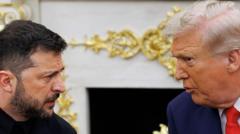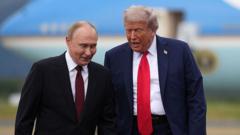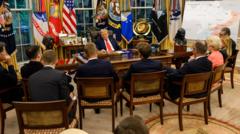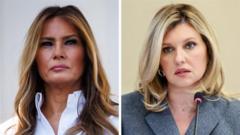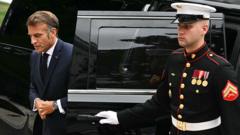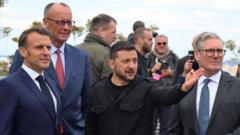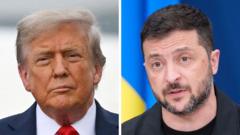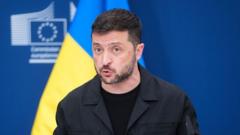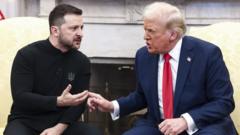President Zelensky's recent discussions with President Trump in Washington highlighted evolving diplomatic strategies amidst the Ukraine crisis, including potential negotiations with Putin and security guarantees, though ceasefire talks remain contentious.
Insights from the Recent Ukraine Talks in Washington
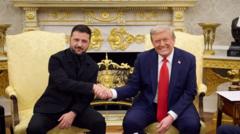
Insights from the Recent Ukraine Talks in Washington
President Zelensky's visit to Washington reveals progress and challenges in addressing the ongoing war in Ukraine.
President Volodymyr Zelensky returned to the White House on Monday to engage in critical discussions with US President Donald Trump concerning the ongoing war in Ukraine. This meeting attracted several European leaders, following Trump's summit with Russian President Vladimir Putin in Alaska, which ended without a ceasefire agreement. Optimistic remarks from Trump, contrasted with cautious evaluations from European partners, left the talks without specific commitments for security guarantees or concrete steps toward peace. Here are the main highlights from the summit.
1. **Potential for a Putin-Zelensky Meeting**
Following the summit, Trump announced plans to facilitate meetings between Putin and Zelensky, including a trilateral meeting to involve the US once initial discussions take place. Despite these announcements, bringing the two leaders together for direct talks—since Russia's full-scale invasion began—will likely face significant challenges. Zelensky's insistence on such a meeting reflects his stance that Russia lacks genuine interest in peace talks, a point only underscored by Moscow's previous resistance to the idea.
2. **European Leaders' Response to Ceasefire Stance**
Trump expressed skepticism about the necessity of a ceasefire before negotiations could start, diverging from Ukraine's position that demands an end to hostilities beforehand. German Chancellor Friedrich Merz voiced firm opposition to proceeding without a ceasefire, advocating for a unified European stance to pressure Russia into compliance. Notably, Zelensky refrained from reiterating his calls for a ceasefire during his statements.
3. **Hints at US Security Guarantees**
In discussions about security, Trump assured Zelensky of US support in any peace deal arrangement, though specifics remained vague. While Trump did not explicitly suggest deploying US troops to Ukraine, he implied ongoing US involvement in guaranteeing Ukrainian security. Notably, Zelensky indicated that the negotiations could include a significant arms deal, aimed at enhancing Ukraine's military capabilities with modern systems, alongside financial support for domestic drone production.
4. **Zelensky's Diplomatic Approach**
In contrast to a previous tense visit, Zelensky aimed to foster goodwill among his hosts, expressing gratitude multiple times within minutes. His change in attire further symbolized this intentional shift towards diplomatic charm. He also facilitated a personal connection by delivering a letter from Ukraine's First Lady to Melania Trump. European leaders similarly expressed appreciation for Trump's leadership in facilitating discussions, although underlying concerns around future security in Europe were evident, as highlighted by French President Emmanuel Macron.
These talks in Washington demonstrate the intricate dynamics of diplomacy surrounding the Ukraine conflict as leaders navigate the complicating factors of military, political, and international relations to seek a pathway towards resolution.


